|
Battle of New Bern, North Carolina
Burnside's North Carolina Expedition
Battle of New Bern
Other Names: New Berne
Location: Craven County
Campaign: Burnside's North Carolina Expedition (February-June 1862)
Date(s): March 14, 1862
Principal Commanders: Brig. Gen. Ambrose E. Burnside [US]; Brig.
Gen. Lawrence O’B. Branch [CS]
Forces Engaged: Expeditionary Force and Foster’s, Reno’s,
and Parke’s Brigades [US]; 5 regiments, militia [CS]
Estimated Casualties: 1,080 total
Description: On March 11, 1862, Brig. Gen. Ambrose E.
Burnside’s command embarked from Roanoke Island to rendezvous with Union gunboats at Hatteras Inlet for an expedition against New Bern. On March 13, the fleet sailed up the
Neuse River and disembarked infantry on the river’s south bank to approach the New Bern defenses. The Confederate defense
was commanded by Brig. Gen. Lawrence O'B. Branch. On
March 14, John G. Foster’s, Jesse Reno’s, and John G. Parke’s brigades attacked along the railroad and after
four hours of fighting drove the Confederates out of their fortifications. The Federals captured nine forts and 41 heavy guns
and occupied a base which they would hold to the end of the war, in spite of several Confederate attempts to recover the town.
The capture of New
Bern reflected another accomplishment towards the fulfillment of General Winfield Scott's "Anaconda Plan." (See also Battle of New Bern: Detailed.)
| Civil War Battle of New Bern, North Carolina |
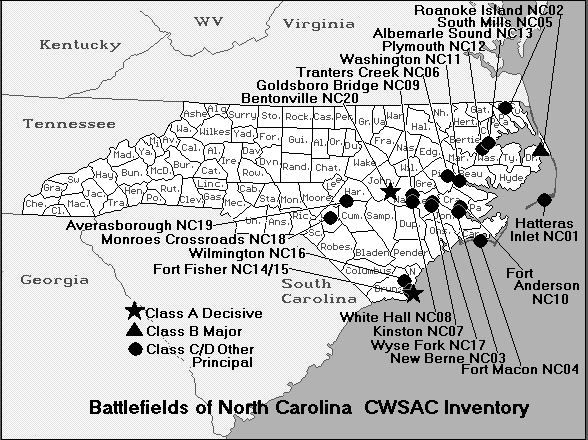
|
| North Carolina Map of Battlefields |
Introduction: The Battle of New Bern (also known as the Battle of New Berne) was fought on March
14, 1862, near the city of New Bern, North Carolina,
as part of the Burnside Expedition of the American Civil War (1861-1865). The Union Army's Coast Division, led by Brigadier
General Ambrose E. Burnside and accompanied by armed vessels from the North Atlantic Blockading Squadron, was opposed by an
undermanned and rather poorly trained and armed Confederate force consisting of North
Carolina soldiers and militia under the command of Brigadier General Lawrence O'B. Branch. Although
the determined defenders would fight from behind protected breastworks that had been constructed long before the battle,
the Southerners would form a thin gray line with a weak center that would soon be realized and exploited
by the Federal soldiers. When the center of the line was penetrated, many of the militia broke, forcing a general retreat
of the entire Confederate force. General Branch would not be able to reform his troops until they had retreated to Kinston, some 30 miles (about 50 km) away. New Bern, an objective in the Union Anaconda Plan, would remain under Union control for the remainder of the war.
Next, the Federals would begin to push inland and destroy the Tar Heel State's infrastructure, including railroads, mills,
depots, plantations, factories, and bridges.
| Civil War North Carolina: Battle of New Bern |
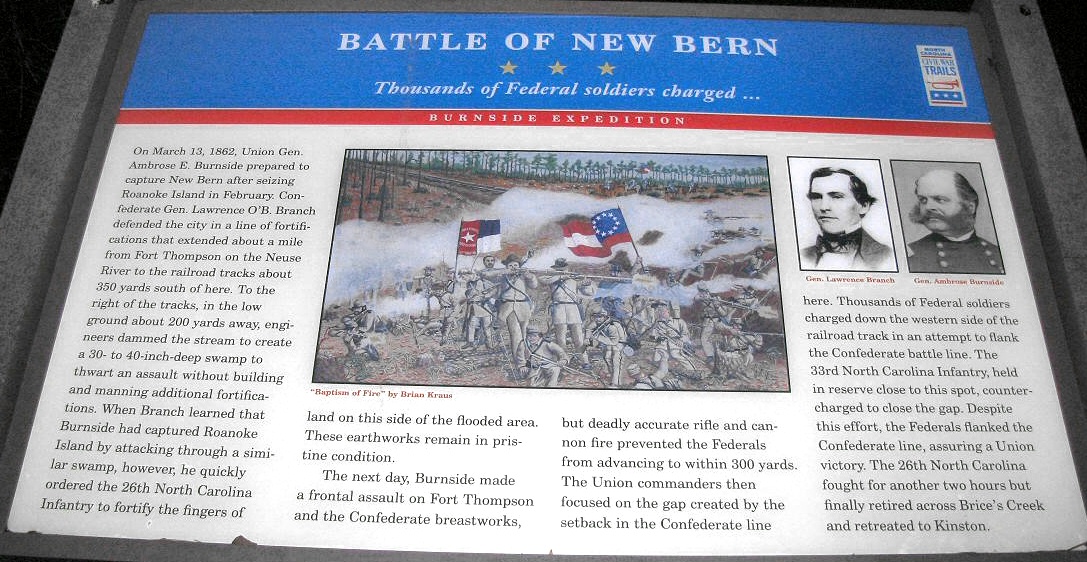
|
| Battle of New Bern Historical Marker |
Geography: New Bern lies on the right (southwest) bank of the
Neuse River, about 37 miles (60 km) above
its exit into Pamlico Sound. The river is quite broad in this vicinity, and is deep enough that vessels that can navigate the sound can also ply
the river. In the colonial era, the town was quite important as a seaport, but by the time of the Civil War Morehead
City and Beaufort had largely supplanted it. Nevertheless, New Bern was still a significant military target, as the railroad (Atlantic
and North Carolina Railroad) that connected the coast with the interior passed through the city. A short distance further
up, at Goldsboro (spelled Goldsborough in the 19th century), the line crossed the Wilmington and Weldon Railroad, noted for keeping the Confederate Army
of Northern Virginia supplied throughout the war. Thus, if New Bern
were to fall into Federal hands, an vital link in the supply chain of that army would be broken. See also North Carolina American Civil War Railroads.
Known as the Coastal Plain,
the land in this part of North Carolina is low and rather
flat, and is sometimes marshy. In 1862, it was mostly covered with open pine forest, although in places it was broken into
low hills with deciduous forests, separated by ravines. It is crossed by many creeks that sometimes rise to the status of
small rivers. One of these, the Trent River, separates New Bern
from the land to its south. Another that is only a little smaller is Slocum's Creek, 16 miles (26 km) farther down the Neuse. It was to be the landing site for the attacking Federal forces. The entire action, aside from
the takeover of the city itself, was confined to the land between these two streams. The railroad ran on a system of berms
and occasional cuts about a mile (1.6 km) inland from the river. Between the tracks and the river was a county road connecting
New Bern with Morehead City and Beaufort; in the manner of the time, the road was unpaved, as the Union soldiers
learned to their sorrow.
| New Bern Civil War Marker |
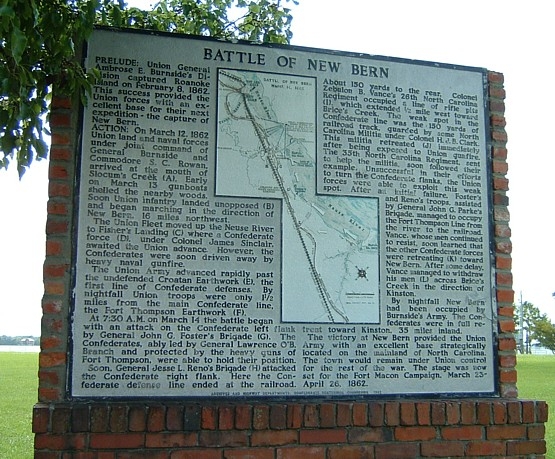
|
| Battle of New Bern Marker |
| NC Harbor Defenses Map |
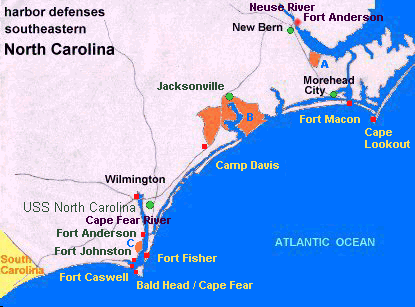
|
| Cape Fear River Defense System |
Background: Following the secession of North Carolina from the Union, the defenses of the state were badly neglected by the Confederate
government in Richmond. The War Department there, directed
at first by Secretary Leroy P. Walker and later by Judah P. Benjamin, drained off its best-trained and best-equipped troops
to take part in the campaigns in Virginia, which were regarded
as more important. When Hatteras Island fell to Union forces in August 1862, only six regiments of infantry were available
to defend the entire coast of the state. Already by that time the coastal defense had been divided into separate districts
for command purposes; the northern part, from near Cape Lookout to the Virginia border, was assigned to Brig. Gen. Daniel
H. Hill, who set up the defensive lines around New Bern expecting that the garrison would ultimately be increased in size,
but he was transferred to service in Virginia before the hoped-for additional troops arrived. Shortly after he was succeeded
by Brig. Gen. Lawrence O'B. Branch, the district was divided again. Branch's command extended from Cape Lookout north only
to the limits of Pamlico Sound. From there to the Virginia
border and beyond was assigned to Brig. Gen. Benjamin Huger, whose primary concern was the defense of Norfolk and environs. This meant in particular that Roanoke Island, between Croatan Sound
and Roanoke Sound just north of Pamlico Sound, was not included in Branch's command.
Roanoke
Island fell to a combined operation of the Union Army's Coast Division, under Brig. Gen. Ambrose E. Burnside,
and a Union gunboat flotilla assembled from the North Atlantic Blockading Squadron, under Flag Officer Louis M Goldsborough,
on February 7–8, 1862. That battle was rapidly followed up by the gunboats alone, who wiped out the Confederate
Navy's Mosquito Fleet in an assault on Elizabeth City. Shortly afterward, Goldsborough had to leave the sounds for duties at Hampton
Roads, and immediate command of the ships he left behind fell to Commander Stephen C. Rowan. As a result of the battles, Union
forces could move at will in Albemarle and Pamlico Sounds.
Every city and town accessible to those sounds hence became vulnerable to attack. The most important was New Bern, and Burnside soon resolved to take it.
The importance of New Bern was no more obvious
to Burnside than it was to the Confederate authorities in Richmond,
but they did little to secure it. Although more than a month passed after Roanoke Island
fell before Burnside could mount an attack on the city, the local command received no reinforcements. One of General Branch's
aides estimated that the lines would need at least 6,130 men to hold them, but he had only about 4,000 at his disposal, a
number often reduced by sickness. Furthermore, many of the men were poorly-armed militiamen. The disparity between necessity
and reality persuaded Branch to draw his lines in, abandoning some of the strong breastworks erected by his predecessor. The
principal defense would be a line based on Fort Thompson,
a work of thirteen guns facing the Neuse River.
The fort was strong, but only three of its thirteen guns would bear on the landward approach.
The Fort Thompson breastworks that were set up
by General Hill extended only from the river to the railroad. They ended on the right in a brickyard that would figure prominently
in the fighting. Because the land farther to the right was fairly firm and would allow his position to be flanked, General
Branch decided to extend the line beyond the railroad and end it in a swamp. This just about doubled the length of the defensive
line. He made a major blunder in laying out the line, however. In haste to complete the extension and faced with an exasperating
shortage of labor, he decided to use a small creek as a natural part of the line. This creek intersected the railroad at a
point some 150 yards (135 meters) up from the brickyard. The line of breastworks therefore had a dogleg in its center.
| Forts protecting Wilmington Weldon Railroad |
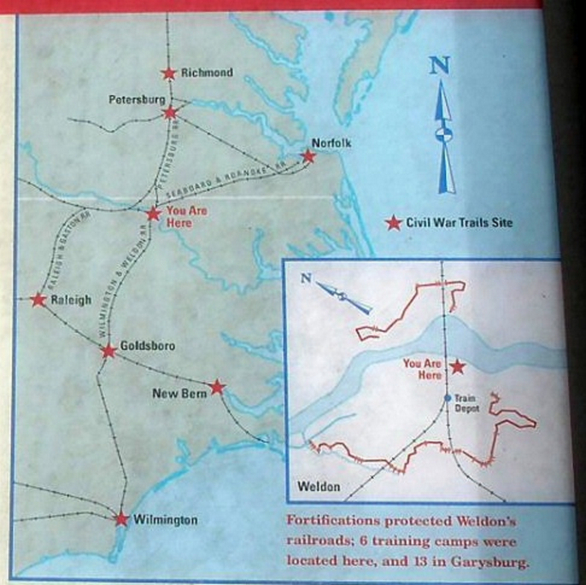
|
| Most Important Railroad of the Civil War |
Opposing Forces
Union Order of Battle
Coast Division of the US
Army (Brig. Gen. Ambrose E. Burnside)
First Brigade (Brig. Gen.
John G. Foster)
10th Connecticut
24th Massachusetts
25th Massachusetts
27th Massachusetts
Second Brigade (Brig. Gen.
Jesse L. Reno)
9th New Jersey
21st Massachusetts
51st New York
51st Pennsylvania
Third Brigade {Brig. Gen.
John G. Parke)
8th Connecticut
11th Connecticut
4th Rhode Island
5th Rhode Island
Unassigned units:
1st New York Marine Artillery
(detachment)
99th New York (Union Coast Guard) (Company B)
Army gunboat Picket
US Naval Forces in Pamlico
Sound (Commander Stephen C. Rowan)
Philadelphia
Stars and Stripes
Louisiana
Hetzel
Underwriter
Delaware
Commodore Perry
Valley City
Commodore Barney
Hunchback
Southfield
Morse
Lockwood
Henry Brinker
Confederate Order of Battle
Pamlico District of the
Department of North Carolina (Brig. Gen. L. O'B. Branch)
7th North Carolina
19th North Carolina (cavalry)
26th North Carolina
27th North Carolina
28th North Carolina
33rd North Carolina
35th North Carolina
37th North Carolina
North Carolina Heavy Artillery
(company)
Special Battalion, North Carolina Militia
| Civil War Battle of New Bern, North Carolina |
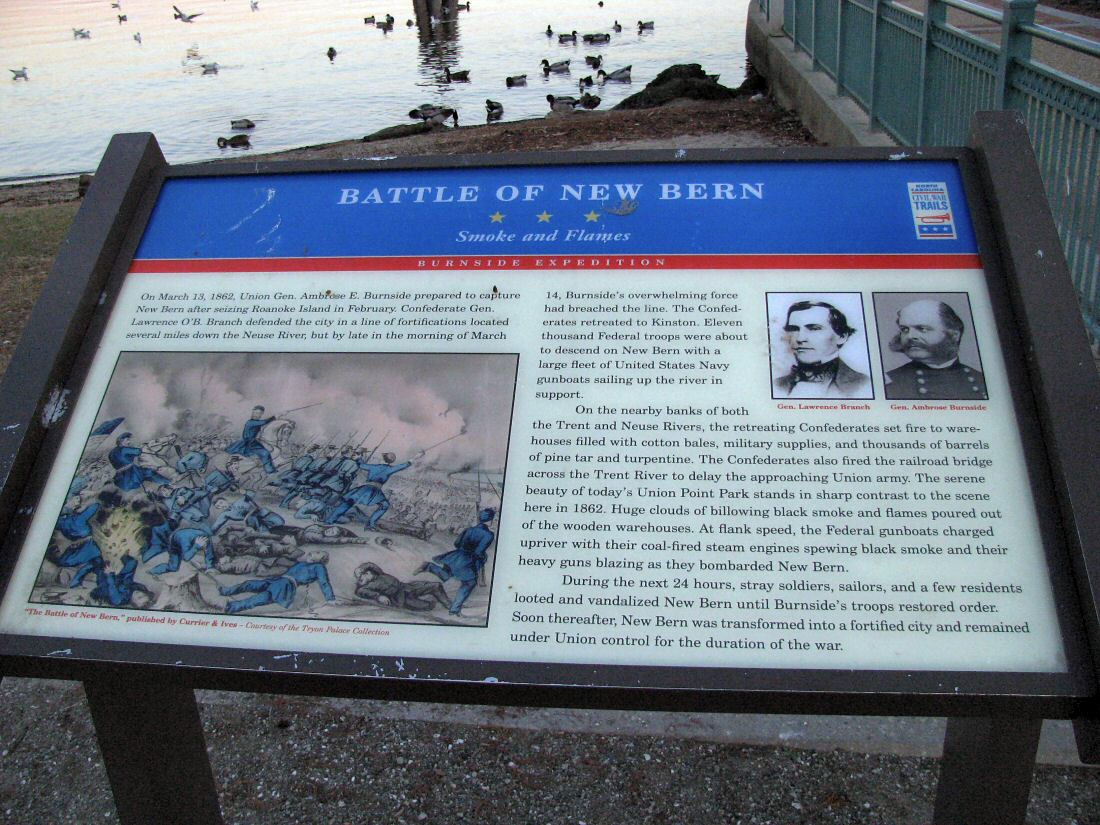
|
| Battle of New Bern, NC |
| New Bern, North Carolina |
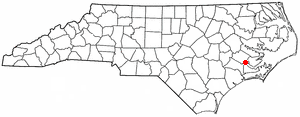
|
| (New Bern Map) |
Advance: The soldiers of the Coast Division clambered into their transports at Roanoke
Island on March 11, 1862, and got under way early the next morning, accompanied by 14 Navy gunboats and one gunboat of their
own. One of the navy vessels was detached to guard the mouth of the Pamlico River,
where it was incorrectly rumored that the Rebels were preparing two ships to cut off transports that might become separated
from navy protection. The main force traversed Pamlico Sound, entered the Neuse
River, and anchored near the mouth of Slocum's Creek at dusk. At dawn
on March 13, the troops began to disembark. A small Rebel unit that was intended to contest the landing was quickly driven
away by fire from the gunboats, and the morning was spent getting men and equipment ashore. With the infantry came six boat
(navy) howitzers and two army howitzers. Because of the weather, Burnside decided to land his other artillery closer to the
enemy lines, but dense fog soon closed in, and he could not communicate with the fleet. His remaining guns were not landed.
A little after noon they
began to move toward the Confederate lines, and at about the same time the rains began. The road was soon turned into mud,
and the mere act of walking required great exertion. The gunners with the howitzers accompanying the infantry soon were exhausted
trying to move their pieces, so a regiment of foot soldiers were detailed to help them. Many of those foot soldiers long remembered
this as the most arduous part of the battle. As they made their slow progress, the gunboats kept a short distance ahead, shelling
places where Rebels might be waiting. Late in the day, the advance forces came upon a line of Confederate breastworks that
looked formidable, but was discovered on closer inspection to have been recently abandoned. General Branch had ordered his
men out of this line, known as the Croatan Works, because he believed that Union naval supremacy would allow Burnside to land
his soldiers behind the works and take them in reverse. He could not defend the entire six miles of river bank between the
line and New Bern with the number of men he had available.
The Coast Division soon
resumed its march. Leaving the Croatan Works, First (Foster's) Brigade moved on the right, following the county road, while
Second (Reno's) Brigade followed the railroad on the left.
Third (Parke's) Brigade followed after the First. They continued until they came in contact with enemy pickets, about a mile
and a half (2 km) away from the Fort Thompson
line held by the Rebels. Daylight having been exhausted, Burnside ordered a halt and had the brigades bivouac in the order
of their march: First Brigade on the right near the road, Second Brigade on the left near the railroad, and Third Brigade
to the rear of the First. The howitzers did not arrive until 0300 the next morning.
| Goldsboro Expedition,aka Foster's Raid |
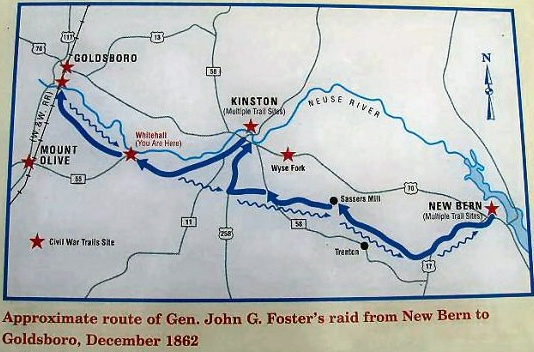
|
| Civil War Strikes New Bern on the North Carolina Coast |
| Confederate Monument, Battle of New Bern |
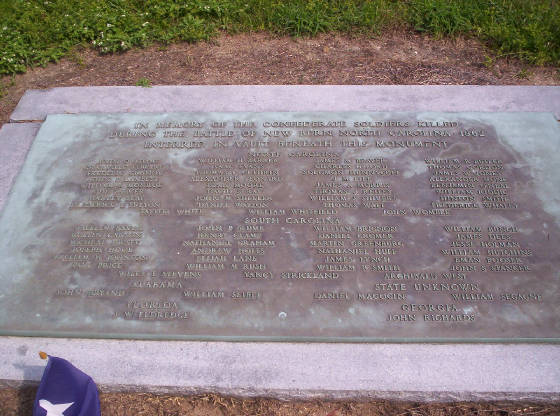
|
| Battle of New Bern Monument |
The Fight: The field was covered by a dense fog on the morning of March 14. Burnside
ordered his forces to form and advance on the Rebel works. The Yankees did not have a complete report concerning the Confederate
disposition at this time. From what the Federals believed, the Confederate line extended only from the river to the brickyard.
In keeping with this knowledge, Burnside ordered the First Brigade to engage the enemy left, while the Second Brigade would
try to turn their right, at the brickyard. The eight howitzers were deployed across the county road. Third Brigade was held
as a reserve. The army also got some dubious support from the gunboats under Commander Cowan, who shelled the Rebel positions
although they were hidden by intervening forests. This gunfire greatly disturbed the North Carolinians, but it was inaccurate enough that Burnside eventually asked Cowan to
change direction.
Meanwhile, on the other
side, General Branch had put his regiments into the line. From his left, at Fort
Thompson, to the brickyard on his right, were the 27th, 37th, 7th, and
35th North Carolina Regiments. His reserve was the 33rd Regiment. The right flank of the 35th was anchored in a brickyard
kiln that was loopholed for artillery. The entire line beyond the railroad was occupied by a single regiment, the 26th North Carolina, plus a few companies of cavalry. The gap in his line
created by the dogleg at the railroad was covered only by his weakest unit, a militia battalion with only two weeks of training,
and armed with shotguns and hunting rifles.
| Battle of New Bern |
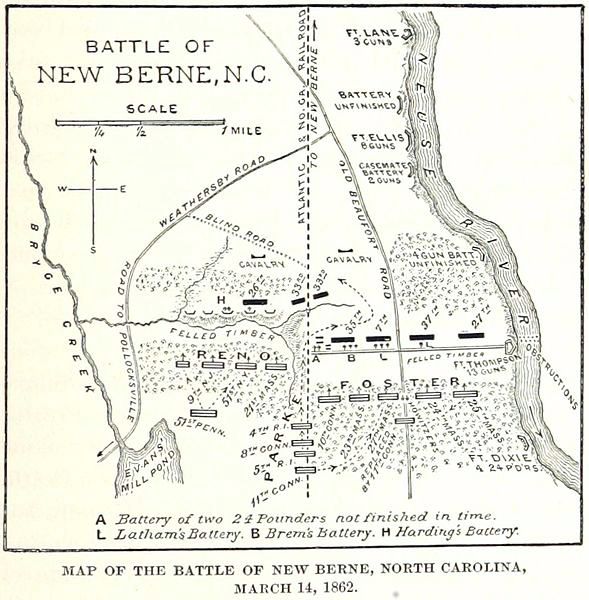
|
| Confederate Line of Battle at New Bern Battlefield |
(Right) New Bern Battlefield Map prepared for Brig. Gen. L. O'B. Branch,
CSA, showing Confederate line of battle for the imminent Battle of New Bern, North Carolina, 14 March 1862. Union positions
added in 1887. Source: The War of the Rebellion: a Compilation of the
Official Records of the Union and Confederate Armies, Ser. I, v. 9, p. 248. Union positions by Battles and Leaders of the
Civil War (1887).
On the Federal left,
General Reno, still unaware of the extension of the enemy lines beyond the railroad, ordered a part of the 21st Massachusetts
to charge the brick kiln, while his other units would engage the enemy in support. The charge was successful at first, but
they then found themselves under fire from the whole line and were forced to pull back.
Burnside at this time ordered
his reserve, the Third Brigade, into the line to support Reno's
Second Brigade. The 4th Rhode Island replaced the 21st Massachusetts,
which had used up its ammunition. While trading places, Colonel Isaac P. Rodman of the 4th Rhode Island
was told by Lieutenant Colonel William S. Clark of the 21st Massachusetts
that he thought that another attack on the brick kiln would be successful. Rodman sent a courier to General Parke informing
him that he was taking responsibility, then formed his regiment and ordered them to charge. Armed with better knowledge of
the enemy, this charge was successful. The 4th Rhode Island
captured nine brass field pieces, and found themselves in rear of the Rebel entrenchments.
At this point, the Confederate
line broke. The rupture started when the green militiamen fled and exposed the units on both of their flanks. Branch ordered
his reserves to plug the gap, but they did not arrive in time. As the line was rolled up on both wings, each regimental commander
in succession pulled his unit back to escape being slaughtered. General Branch ordered a retreat, which soon became a rout.
The fleeing North Carolinians dashed across the bridge over the Trent River into New
Bern, then burned the bridge so precipitately that some of their compatriots were left behind and were
captured. Even in New Bern, however, they were not safe, as the Union
warships were there ahead of them, so the retreating units could not reform until they had fled all the way to Kinston.
Branch had lost 64 killed,
101 wounded, and 413 captured or missing, compared to Burnside's 90 killed, 380 wounded, and a single man captured. Casualty
figures, however, for this battle vary slightly.
Aftermath: New
Bern fell and was occupied. It remained in control of the Union Army for the rest of the war. Immediately
following the battle, Burnside turned his attention to his next important objective, getting control of the port at Beaufort,
which was defended by Fort Macon.
The Rebels did not defend Morehead City,
which was occupied immediately by the Yankees, or Beaufort, which was taken on March 25. The siege of Fort Macon began at that time.
| North Carolina Civil War Battle Map |
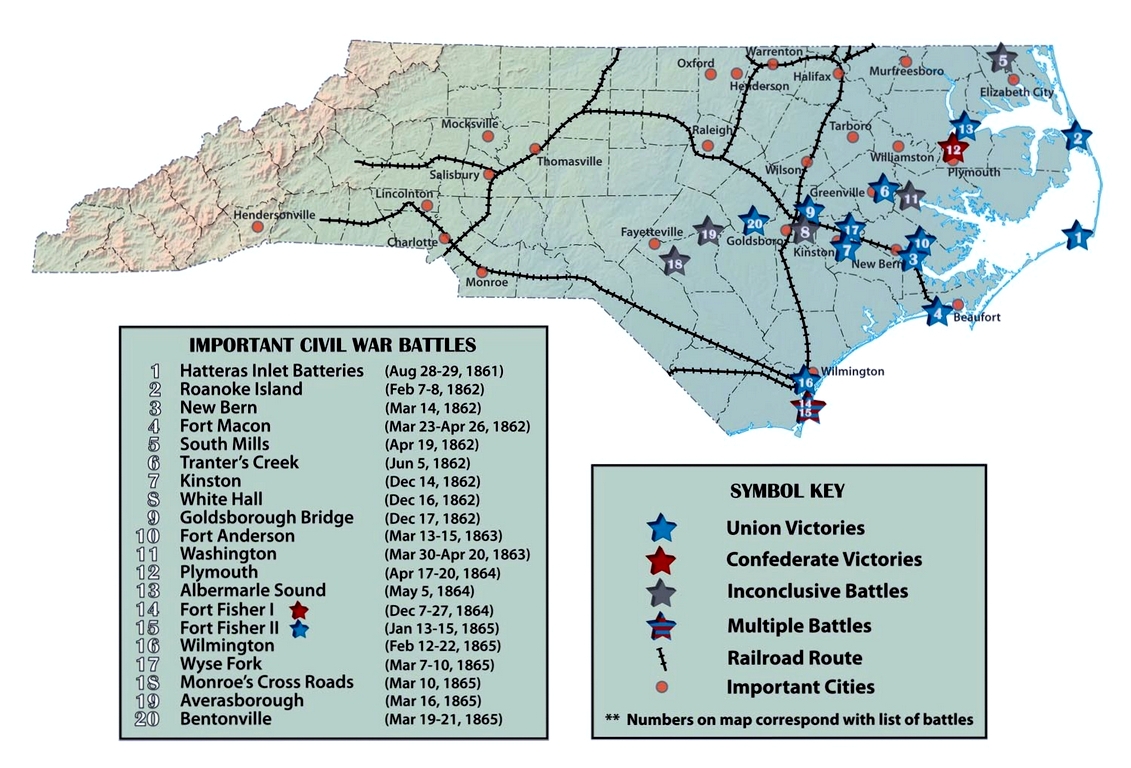
|
| Battle of New Bern |
| Battle of New Bern, NC |
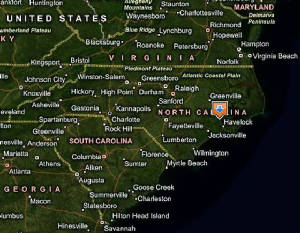
|
| New Bern, North Carolina |
New Bern National Cemetery: New
Bern National Cemetery is located in New Bern, Craven County, N.C. Founded in 1710, New Bern is the second-oldest city in
the state, founded by German and Swiss adventurers whose commander was from a city of the same name in Switzerland. Prior
to the American Revolution, Royal Gov. William Tryon made this seaport his colonial capitol and commissioned the construction
of Tryon Palace in 1770.
Although there was some dissension within the state regarding secession,
North Carolina chose to leave the Union on May 20, 1861. Ultimately, it supplied more men and materials to the Confederate
cause than any other southern state. It also suffered the largest number of losses. New Bern was captured early in the war.
By August 1861, the Federals had secured the Pamlico Sound inlets after defeating the Confederate forces and taking Forts
Clark and Hatteras. By winter 1862, Gen. A.E. Burnside and Commodore L.M. Goldsborough had seized the Confederate positions
on Roanoke Island and New Berne (as it was originally spelled). Union control of the inner coastal position tightened the
blockade of the North Carolina coast, but the state resisted until April 26, 1865, when Gen. Joseph Johnston surrendered
the last major Confederate army to Gen. William T. Sherman near Durham, N.C.
New Bern National Cemetery was officially established Feb. 1, 1867. Many
of the burials at New Bern are reinterments of remains from the surrounding area, including Beaufort, Hatteras and locations
along the coast. With over 1,000 unknowns buried in a separate section, New
Bern National Cemetery was listed on the National Register of Historic Places in 1997.
Monuments and Memorials
The granite New Jersey Monument was erected by
that state in 1905 and is dedicated to the memory of the 9th New Jersey Regiment Volunteer Infantry. The Massachusetts Monument is a granite memorial erected by the commonwealth in 1908 in memory
of Massachusetts’s soldiers and sailors who died in North Carolina during the Civil War. The
Connecticut Monument was erected by that state in 1908. The memorial was dedicated to the memory of Connecticut men who died
of yellow fever during the conflict, as well as those who fell in action by 1865. The
Rhode Island Monument is composed of a granite base topped by a bronze figure. Dedicated Oct. 6, 1909, it was donated by the
state of Rhode Island in honor of its volunteers who died in North Carolina during the late war. The monument was designed
and sculpted by William W. Manatt of Providence, R.I.
New Bern National Cemetery is located on 1711 National Avenue, New Bern,
N.C. 28560, and the cemetery remains closed to new interments.
(Sources and related reading listed at bottom of page.)
Recommended Reading: The
Civil War on the Outer Banks: A History of the Late Rebellion Along the Coast of North Carolina from Carteret to Currituck
With Comments on Prewar Conditions and an Account of (251 pages). Description: The ports at Beaufort, Wilmington, New Bern and Ocracoke, part of the Outer Banks (a chain
of barrier islands that sweeps down the North Carolina coast from the Virginia Capes to Oregon Inlet), were strategically
vital for the import of war materiel and the export of cash producing crops. From official records, contemporary newspaper
accounts, personal journals of the soldiers, and many unpublished manuscripts and memoirs, this
is a full accounting of the Civil War along the North Carolina
coast.
Recommended Reading: The Civil War in the Carolinas
(Hardcover). Description: Dan Morrill relates the experience
of two quite different states bound together in the defense of the Confederacy, using letters, diaries, memoirs, and reports.
He shows how the innovative operations of the Union army and navy along the coast and
in the bays and rivers of the Carolinas affected the general course of the war as well as
the daily lives of all Carolinians. He demonstrates the "total war" for North
Carolina's vital coastal railroads and ports. In the latter part of the war, he describes
how Sherman's operation cut out the heart of the last stronghold
of the South. Continued below...
The author
offers fascinating sketches of major and minor personalities, including the new president and state governors, Generals Lee,
Beauregard, Pickett, Sherman, D.H. Hill, and Joseph E. Johnston. Rebels and abolitionists, pacifists and unionists, slaves
and freed men and women, all influential, all placed in their context with clear-eyed precision. If he were wielding a needle
instead of a pen, his tapestry would offer us a complete picture of a people at war. Midwest Book Review: The Civil War in the Carolinas by civil war expert and historian
Dan Morrill (History Department, University of North Carolina at Charlotte, and Director of the Charlotte-Mecklenburg Historical
Society) is a dramatically presented and extensively researched survey and analysis of the impact the American Civil War had
upon the states of North Carolina and South Carolina, and the people who called these states their home. A meticulous, scholarly,
and thoroughly engaging examination of the details of history and the sweeping change that the war wrought for everyone, The
Civil War In The Carolinas is a welcome and informative addition to American Civil War Studies reference collections.
Recommended Reading: The Civil War
in Coastal North Carolina (175 pages) (North Carolina Division of Archives and History). Description: From the drama of blockade-running to graphic descriptions of battles
on the state's islands and sounds, this book portrays the explosive events that took place in North Carolina's
coastal region during the Civil War. Topics discussed include the strategic importance of coastal North Carolina, Federal occupation of coastal areas, blockade-running, and the impact of
war on civilians along the Tar Heel coast.
Recommended Reading: Storm
over Carolina: The Confederate Navy's Struggle for Eastern North Carolina. Description: The struggle for control of the eastern
waters of North Carolina during the War Between the States
was a bitter, painful, and sometimes humiliating one for the Confederate navy. No better example exists of the classic adage,
"Too little, too late." Burdened by the lack of adequate warships, construction facilities, and even ammunition, the
South's naval arm fought bravely and even recklessly to stem the tide of the Federal invasion of North
Carolina from the raging Atlantic. Storm
Over Carolina is the account of the Southern navy's struggle in North
Carolina waters and it is a saga of crushing defeats interspersed with moments of brilliant and even
spectacular victories. It is also the story of dogged Southern determination and incredible perseverance in the face
of overwhelming odds. Continued below...
For most of
the Civil War, the navigable portions of the Roanoke, Tar, Neuse, Chowan, and Pasquotank rivers were
occupied by Federal forces. The Albemarle and Pamlico sounds, as well as most of the coastal towns and counties, were also
under Union control. With the building of the river ironclads, the Confederate navy at last could strike a telling blow against
the invaders, but they were slowly overtaken by events elsewhere. With the war grinding to a close, the last Confederate vessel
in North Carolina waters was destroyed. William T. Sherman
was approaching from the south, Wilmington was lost, and the
Confederacy reeled as if from a mortal blow. For the Confederate navy, and even more so for the besieged citizens of eastern
North Carolina, these were stormy days indeed. Storm Over Carolina describes their story, their struggle, their history.
Recommended Reading: Graveyard of the Atlantic: Shipwrecks of the North Carolina
Coast (The University of North Carolina Press). Description: This outstanding research of the shipwrecks off the North Carolina
Coast includes: a detailed listing of shipwrecks along the North Carolina Coast and Outer Banks; detailed accounts of most
of the shipwrecks and, in some cases, the author gives extensive details, e.g., he devotes a chapter to the Steam Packet Pulaski. Continued below...
The author provides a chronological listing at the end of the book, a detailed
index, and descriptive drawings of the various types of ships along with a map of the area. For anyone interested in ships,
shipwrecks, the NC Outer Banks, then this is a great read.
Recommended Reading: Confederate Military History Of North Carolina: North Carolina In
The Civil War, 1861-1865. Description:
The author, Prof. D. H. Hill, Jr., was the son of Lieutenant General Daniel Harvey Hill (North
Carolina produced only two lieutenant generals and it was the second highest rank in the army) and
his mother was General “Stonewall” Jackson’s wife's sister. In Confederate
Military History Of North Carolina, Hill discusses North Carolina’s massive
task of preparing and mobilizing for the conflict; the many regiments and battalions recruited from the Old North State;
as well as the state's numerous contributions during the war. Continued below...
During Hill's Tar Heel State
study, the reader begins with interesting and thought-provoking statistical data regarding the 125,000 "Old North State"
soldiers that fought during the course of the war and the 40,000 that perished. Hill advances with the Tar Heels to the first
battle at Bethel, through numerous bloody campaigns and battles--including North
Carolina’s contributions at the "High Watermark" at Gettysburg--and concludes
with Lee's surrender at Appomattox.
References: National Park Service;
Browning, Robert M. Jr., From Cape Charles to Cape
Fear: the North Atlantic Blockading Squadron during the Civil War. Univ. of Alabama, 1993; Campbell, R. Thomas, Storm over
Carolina: the Confederate Navy's Struggle for Eastern North
Carolina. Cumberland House, 2005; Davis, George B., Leslie J. Perry, and Joseph W. Kirkley, Atlas
to accompany the Official Records of the Union and Confederate Armies, Government Printing Office, 1891–1895; reprint,
Arno, 1978; Johnson, Robert Underwood, and Clarence Clough Buel, Battles and Leaders of the Civil War. Century, 1887, 1888;
reprint ed., Castle, n.d; Trotter, William R., Ironclads and Columbiads: The Coast. Joseph F. Blair, 1989; US Navy Department,
Official Records of the Union and Confederate Navies in the War of the Rebellion. Series
I: 27 volumes. Series II: 3 volumes. Washington: Government Printing Office, 1894–1922;
US War Department, A Compilation of the Official Records of the Union and Confederate Armies.
Series I: 53 volumes. Series II: 8 volumes. Series III: 5 volumes. Series IV: 4 volumes. Washington:
Government Printing Office, 1886–1901; Microsoft Virtual Earth (2D) and Microsoft Virtual Earth (3D);
Department of Veterans Affairs.
|

